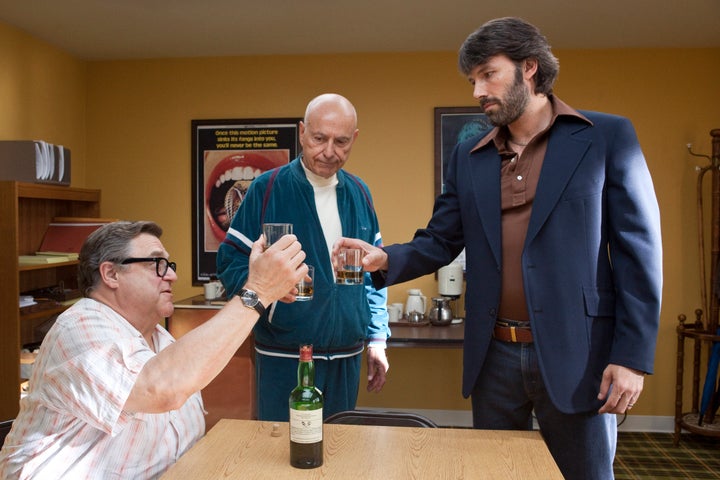
WARNING: This post contains plot spoilers. If you have not seen this film, read on at your own discretion.
Hollywood producer Lester Siegel (Alan Arkin) misquotes Karl Marx in Ben Affleck's third directorial film, Argo, calling a rescue mission "a farce that turns into a tragedy" (the actual quote is, "history repeats itself, first as a tragedy, and second as a farce.") -- but that misquote is what Argo, itself, is. The farce is Hollywood; the tragedy is our continual, and cyclical involvement in Middle Eastern countries.
Before telling one portion of the story of Iranian civilians and troops storming the U.S. embassy and holding American hostages for 444 days, Affleck uses animated storyboards (similar to those used for filming) to give a brief history of the Iranian view of the U.S. involvement following the overthrow of their democratically elected leader president Mohammed Mosaddegh (who nationalized their oil barracks). The narrator describes the miserable conditions Iranians endured for decades under the U.S.-backed shah, until he was overthrown and given exile in the States. After the revolution occurs and the militants are bent on killing or detaining any Americans left in the country until the shah is returned to be hanged, a C.I.A. operative openly admits that the U.S. essentially started the bloodbath by removing Mosaddegh.
Affleck aims for a sense of moral equivalency by counterbalancing footage of Iranian revolutionaries burning the American flag with archival news broadcasts of angry Americans setting fire to an Iranian flag, the attack of an Iranian-American man in front of cameras in Houston and (history repeats itself) news footage of the U.S. selling weapons to Afghanistan to fight the Soviets. Affleck also gives us a conflicted Iranian civilian: a housekeeper (Sheila Vand) whose observance of eight escaped American embassy employees who've sought refuge at the Canadian Ambassador's (Victor Garbor) house, has put her own life in danger.
Despite these careful attempts of counter-balance of equal rage, what Affleck has made is a taut, suspenseful throwback Western: the old Cowboy vs. Indians fable. This is the true story of Tony Mendez (Affleck) an exfiltration expert, who came up with the guise of creating Canadian identities for the American refugees to pose as a film crew in Tehran, sent to scout locations for an exotic low-budget, sci-fi movie called "Argo" (an existing script in the possession of Siegel). This plan hopes to be able to get them safely to the airport and back to North America. Argo opens with a siege on the embassy that is as suspenseful and raw as Z (showing the unpredictability of those storming the building, those inside frantically shredded and destroying evidence, before following those that are able to escape undetected out the backdoor and later).
Mendez's idea of extraction needs to be sold in Hollywood where he has to find some real Hollywood producers to create a fake movie, and an airtight alibi. This is where the farce comes into play. Arkin and John Goodman (playing the Oscar-winning makeup artist John chambers, who worked on The Planet of the Apes and created Spock's ears for Star Trek) have great fun as the Hollywood players who know the moves to sell a lie in Hollywood. Their scenes are crass and entertaining (particularly when Siegel goes to get the rights to the script from an agent and tells confident lies in order to get the price down -- a nice parallel to the quality of lies that the escaped Americans will have to master in order to leave the Tehran airport), but -- while integral to the story, gleeful potshots at Hollywood actually feel clunky in a very tight suspense film.
After haggling with an agent (Richard Kind), Siegel remarks that "John Wayne's been dead for six months and the whole world goes to [hell]." Argo is, at heart, a politicized old-school western, and Affleck is the John Wayne character: a loner, not part of any group, war tested; he who decides, after drinking scotch alone, to go rogue and remove the Americans on his own, outside of the Iranian border (Indian territory). And as all true stories go, Affleck had to condense real people into conglomerate individuals, but his decision to reduce the involvement of the Canadian government to wonderfully understanding innkeepers (they actually provided the passports and airline tickets, amongst many other quick government movements while America was bogged down in red tape about action) creates the ultimate Hollywood set-up: the will of one American to save the lives of other Americans. But this decision isn't foolhardy or entirely flag-waving: it does create more tension. Argo is The Searchers in Iran, and the film functions best as a thriller. As real life survivor Mark Lijek explains in a comment at Slate Magazine: "The bottom line. I'm glad I lived through our version rather than Ben Affleck's. His is a lot scarier, but clearly a lot more fun for audiences."
Extremely well-edited by William Goldenberg, the film is fraught with tension -- both in rushing to the airport and in interrogations. The performances across the board are very good, particularly Bryan Cranston as Mendez's CIA contact and Scoot McNairy, one of the eight escapees who is skeptical of trusting Mendez and his plan of getting them out safely.
The pieces all fit handsomely in Argo and Affleck is a natural director -- the only section that feels like an outlier is Hollywood. Perhaps it is because Hollywood is a known farce already, a detached place where people like to feel like they are at war, but more likely it's because history has repeated itself very recently. After shooting Argo, the U.S. embassy in Libya was attacked, resulting in the death of U.S. Ambassador Chris Stevens. That planned attack used the pretext of retaliation for an unfinished, amateur YouTube video that denounced the prophet Mohammed. History has repeated itself, but it's hard to view it as a farce or uplifting. The cycle of tragedy is, more often than not, more tragedy.
NOTE: Be sure to sit through the credits, following the photographs of the real people portrayed in the film, there is a message from former president Jimmy Carter. And for a fact check after viewing the film the aforementioned "Slate" article is worth reading.
